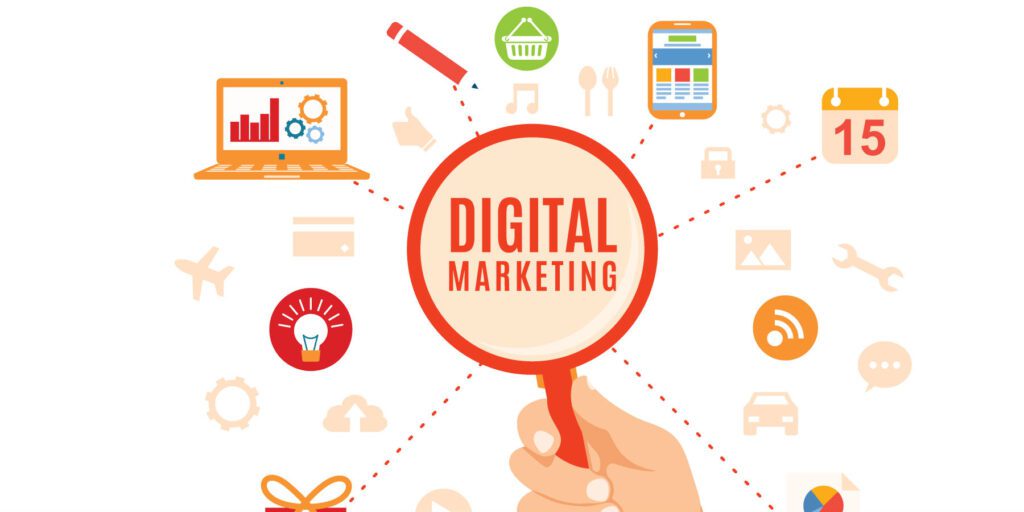Regardless of what your company sells, digital marketing still involves building out buyer’s personas to identify your audience’s needs and creating valuable online content.
B2B Digital Marketing
If a company is business-to-business (B2B), digital marketing efforts are likely to be centered on online lead generation, with the end goal being for someone to speak to a salesperson. The role of your marketing strategy is to attract and convert the highest quality leads for salespeople via your website and supporting digital channels. Beyond the website, you’ll probably choose to focus efforts on business-focused channels like LinkedIn where your demographic is spending their time online.
B2C Digital Marketing
If your company is business-to-consumer (B2C), depending on the price point of products, the goal of digital marketing efforts is to attract people to the website and have them become customers without ever needing to speak to a salesperson. For that reason, you’re probably less likely to focus on ‘leads’ in their traditional sense, and more likely to focus on building an accelerated buyer’s journey, from the moment someone lands on your website, to the moment that they make a purchase. This will often mean your product features in your content higher up in the marketing funnel than it might for a B2B business, and you might need to use stronger calls-to-action (CTAs). For B2C companies, channels like Instagram and Pinterest are more valuable than business-focused platforms LinkedIn.
Website Traffic
You can see the exact number of people who have viewed your website’s homepage in real-time by using digital analytics software, available in marketing platforms like Hub Spot. Also how many pages they visited, what device they were using, and where they came from, amongst other digital analytics data. This intelligence helps you to prioritize which marketing channels to spend more or less time on, based on the number of people those channels are driving to your website. For example, if only 10% of your traffic is coming from organic search, you know that you probably need to spend some time on SEO to increase that percentage.
Content Performance and Lead Generation
Imagine you’ve created a product brochure and posted it through people’s letterboxes — that brochure is a form of content, albeit offline. The problem is no idea how many people opened your brochure or how many people threw it straight into the trash.
Attribution Modeling
An effective digital marketing strategy combined with the right tools and technologies allows you to trace all sales back to the customer’s first digital touchpoint with your business is called attribution modeling. It allows identifying trends in the way people research and buys your product, helping you to make more informed decisions about what parts of your marketing strategy deserve more attention, and what parts of your sales cycle need refining. Connecting the dots between marketing and sales is hugely important — according to Aberdeen Group, companies with strong sales and marketing alignment achieve a 20% annual growth rate, compared to a 4% decline in revenue for companies with poor alignment. If you can improve your customer’s’ journey through the buying cycle by using digital technologies, then it’s likely to reflect positively on your business’s bottom line.
Collaborative Environment
A collaborative environment can be set up between the organization, technology service provider, and digital agencies to optimize effort, resource sharing, reusability, and communications. Organizations are inviting their customers to help them better understand how to service them. Much of this is acquired via company websites where the organization invites people to share ideas that are then evaluated by other users of the site.
Using this method of acquiring data and developing new products can foster the organization’s relationship with its customer as well as spawn ideas that would otherwise, be overlooked.
Data-driven advertising
Users generate a lot of data in every step they take on the path of customer journey and Brands can now use that data to activate their known audience with data-driven programmatic media buying. Without exposing customers’ privacy, users’ data can be collected from digital channels (e.g.: when a customer visits a website, reads an e-mail, or launches and interact with a brand’s mobile app), brands can also collect data from real-world customer interactions, such as brick and mortar stores visits and from CRM and Sales engines datasets. Data-driven advertising is empowering brands to find their loyal customers in their audience and deliver in real time much more personal communication, highly relevant to each customer’s moment and actions.
Remarketing
Remarketing plays a major role in digital marketing. This tactic allows marketers to publish targeted ads in front of an interest category or defined
audiences, generally called searchers in web speak, they have either searched for particular products or services or visited a website for some purpose.
Game advertising
Game ads are advertisements that exist within computer or video games. One of the most common examples of in-game advertising is billboards appearing in sports games. In-game ads also might appear as brand-name products like guns, cars, or clothing that exist as gaming status symbols.





